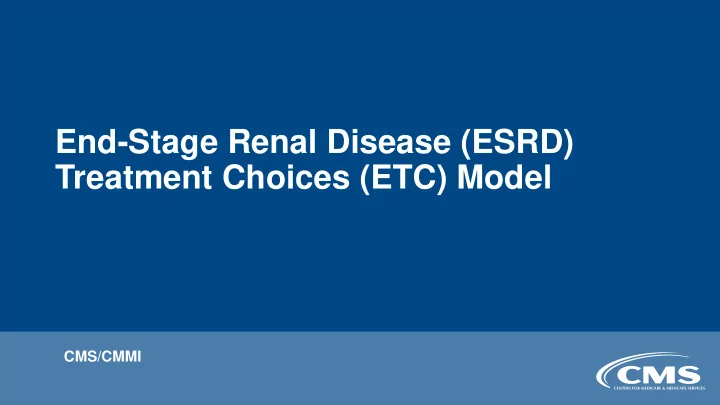

End-Stage Renal Disease (ESRD) Treatment Choices (ETC) Model CMS/CMMI
End-Stage Renal Disease (ESRD) Treatment Choices (ETC) Model The proposed End-Stage Renal Disease (ESRD) Treatment Choices (ETC) Model is included in the Medicare Program; Specialty Care Models to Improve Quality of Care and Reduce Expenditures Notice of Proposed Rule Making. The proposed rule (CMS-5527-P) is available for download from the Federal Register at: https://www.federalregister.gov/documents/2019/07/18/2019-14902/medicare- program-specialty-care-models-to-improve-quality-of-care-and-reduce-expenditures The deadline for submitting comments on the proposed rule is no later than 5 p.m. Eastern Standard Time on September 16, 2019. 2
Kidney Care First (KCF) Model and Comprehensive Kidney Care Contracting (CKCC) Models CMS/CMMI
Kidney Care First (KCF) and Comprehensive Kidney Care Contracting (CKCC) Models Build on CEC Model Comprehensive ESRD Care (CEC) Model KCF and CKCC Models • CEC Model began in October 2015 and • KCF and CKCC begin in 2020 and will will run through December 31, 2020. run through 2023 with the option for CMMI to extend the Models for one or • Accountable Care Organizations (ACOs) two additional years. formed by dialysis facilities, nephrologists, and other Medicare • Single set of providers and suppliers providers and suppliers work together responsible for patient’s care from CKD with the goal to improve outcomes and Stages 4,5 through dialysis, reduce per capita expenditures for transplantation, or end of life care. aligned ESRD beneficiaries. • Results for the Model showed lower spending relative to benchmark group and improvements on some utilization and quality measures. 4
KCF and CKCC Models will improve on CEC Goals of KCF and CKCC: • Later and better starts on dialysis for beneficiaries with CKD. • Better coordination of care for beneficiaries with CKD and ESRD to reduce total cost of care. • More beneficiaries receiving kidney transplants and staying off of dialysis for longer. • Offering different financial risk options for nephrologists and other providers and suppliers to take on financial accountability. KCF and CKCC will include: • Beneficiaries across the full spectrum of kidney disease including CKD Stages 4, 5 and ESRD as well as beneficiaries who receive kidney transplants. • Nephrologist payment reforms. • Additional Medicare benefit enhancements. 5
Overview of the KCF and CKCC Models Payment Options Overview Participants Based on the Primary Care First (PCF) Model – nephrology practices will be eligible to receive Kidney Care First (KCF) Model Nephrologists/nephrology practices only payment adjustments for effective management of beneficiaries Based on existing CEC Model One-Sided Risk Track – allowing certain participants to begin under a Graduated Model lower-reward one-sided model and incrementally phase in risk and additional potential reward Must include nephrologists and Based on the Professional Population-Based nephrology practices; may also include Payment option of the Direct Contracting Model – transplant providers, dialysis facilities, Professional Model with 50% of shared savings or shared losses in the and other kidney care providers on an total cost of care for Parts A and B services optional basis Based on the Global Population-Based Payment option of the Direct Contracting Model – with risk for Global Model 100% of the total cost of care for all Parts A and B services for aligned beneficiaries 6
Key Payment Mechanisms • Adjusted Monthly Capitated Payment (AMCP): Adjusted monthly payment to equalize payments for managing a beneficiary who dialyzes at home and payments for managing an in-center dialysis beneficiary. • CKD Quarterly Capitated Payment (CKD QCP): Quarterly payment to manage aligned CKD 4 / 5 beneficiaries equivalent to monthly AMCP amount for aligned ESRD beneficiaries. • Kidney Transplant Bonus (KTB): Bonus payment of up to $15,000 paid out over three years for every successfully transplanted beneficiary whose transplant stays healthy. • Performance Based Adjustment (PBA): (KCF Only) Adjustment to model payments made to participating KCF practices based on participant’s performance on certain quality and utilization measures. • Shared Savings / Shared Losses: (CKCC Only) Based on total cost of care compared to benchmark or through a voluntary capitation mechanism. 7
KCF and CKCC Models Timeline and Next Steps Model Timeline: • The Models will run from January 1, 2020 through December 31, 2023, with the option for CMS to extend the Model for one or two additional years. • Selected providers and suppliers will begin model participation in 2020 with a focus on building necessary care relationships and infrastructure. • Payment adjustments will begin in 2021. • CMS expects the Request for Applications to be released Summer 2019 and applications will be due back in Fall 2019 More information will be available at https://innovation.cms.gov. Sign up via email and follow CMS on Twitter (@CMSinnovates). 8
Recommend
More recommend